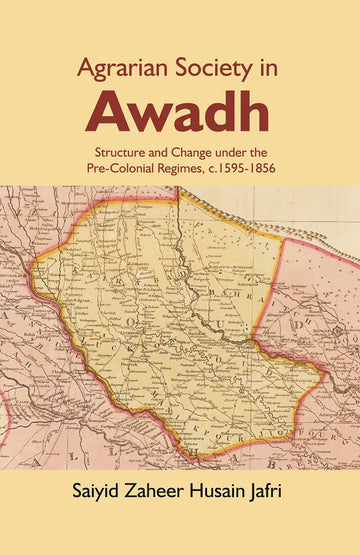Agrarian Society in Awadh: Structure and Change under the Pre-Colonial Regimes, c.1595-1856
Regular price
₹ 884
Sale price
₹ 884
Regular price
₹ 950
Unit price
Save 7%
| Item Weight | 400 Grams |
| ISBN | 978-8121221979 |
| Author | Saiyid Zaheer Husain Jafri |
| Language | English |
| Publisher | Gyan Publishing House |
| Pages | 262 p |
| Book Type | Hardbound |
| Dimensions | 25 X 15 X 5 |
| Publishing year | 2022 |
| Return Policy | 5 days Return and Exchange |

Agrarian Society in Awadh: Structure and Change under the Pre-Colonial Regimes, c.1595-1856
Product description
Shipping & Return
Offers & Coupons
ABOUT THE BOOK Awadh was not one of the provinces which figures prominently in the political history of the Mughal Empire, at any rate after the early years of Akbar's reign to the end of Aurangzeb's. It gained in prominence under the Nawab Wazirs, in the 18th century and thereafter claimed attention still more as classic example of a native state under the subsidiary system of the East India Company. Its administration was stridently criticized by British officials, who particularly condemned the state of agrarian society under the Awadh rulers, and used this criticism as one of the justifications for the annexation of Awadh in 1856. It is difficult to find much to commend in the kingdom of Awadh during the early nineteenth century. Yet, despite the manifold evils by which it was beset, the Awadh system was not one of the total spoilation or anarchy as has been described by its critics. Its very ineptitude protected the peasants and the zamindars of Awadh from the extreme distress which the mahalwari system of the colonial rule imposed contemporaneously on the adjoining ceded and conquered provinces. The study serves as the background to understand Lord Canning's proclamation and subsequent policies the British Crown adopted to win over the belligerent landed overlords of this region and provided numerous concessions to the class of talluqadars. Based heavily on the Persian archival data, family papers, and the British official records, the study hopefully provides some corrective to much of the larger literature available on the subject. ABOUT THE AUTHOR Saiyid Zaheer Husain Jafri, Professor, Department of History, University of Delhi, is known for his researches on numerous aspects of pre-colonial Awadh and Upper Gangetic Valley. His works include Beyond the Chronicle: 'Recovering' Histories of the Institutions and Families (Persian Documents in India, 17th-19th C.) (2021); Delhi and Awadh during 1857: Studies, Images, and Documents (2020), Awadh: From Mughal to Colonial Rule, (1998; revd. edn., 2016) and co-edited, The Great Uprising of 1857; Studies, Commentaries and Documents (2009), and The Islamic Path: Sufism, Politics and Society in India (2006). He has also compiled, for the Indian History Congress, Recording the Progress of Indian History: Symposia Papers of the Indian History Congress 1992-2010 (2012) and History, Ideas and Society: S.C. Mishra Memorial Lectures in History (2014). His other works include Al Ghars al Wahdi fi Rasa'il al Shaikh Naim bin al Mahdi in Arabic (2016), Masnad-e Faqr-o Irshad: Tareekh Khanwada-e Karimia Naeemia Salon (2003), Ahd- e Wusta ka Hindustan: Tasawwuf, Adab Aur Muslim Thaqafat (2008) in Urdu and Awadh ki ek Sufi Sanstha: Khanqah –e karimia Salon (2016) in Hindi. His present research interests encompass documenting the histories of Sufi institutions, the Great Uprising of 1857, transmission of knowledge and colonial impact on the Indo-Muslim institutions of learning and waqf. CONTENTS Preface . 9 Introduction . 13 1. The Geographical Setting. 23 (a) The Natural Environment . 23 (b) Administrative Divisions . 29 2. Extent of Cultivation and Population . 41 (a) Cultivation . 41 (b) Population and its Composition . 46 3. Agricultural Production . 53 (a) Crops, Yields and the Productivity . 53 (b) Means of Cultivation and Irrigation . 62 4. The Land Revenue System Under the Mughals. 69 5. Land Revenue System Under The Nawab Wazirs . 81 6. The Zamindars. 101 (a) Zamindari Rights and their Nature . 101 (b) Changes in Composition of the Zamindar Class . 114 (c) Armed Power of the Zamindars . 132 7. Jagirs in Awadh. 157 (a) Seventeenth Century . 157 (b) Administration of Jagirs . 159 (c) Collapse of the Jagir System. 167 (d) In’am Al-tamgha . 168 8. Origin and Growth of Talluqadari Tenures in Awadh . 181 9. Revenue Grants and the Grantees . 197 (a) Revenue Grants . 197 (b) Revenue Grantees . 209 (i) The Mystic Family at Salon . 209 (ii) Sayyid Muhammad ‘Arif’s Family, Bahraich . 218 (iii) Qazi ‘Imaduddin’s Family, Sandila . 222 10. Agrarian Conditions in Awadh on the Eve of Annexation . 233 (a) The Impact of British Intervention . 233 (b) Bengal Army Sepoys as a Factor in Agrarian Instability . 240 11. Bibliography . 245 Index . 253 Maps . 35 (1) Annual Average Rainfall in Mughal suba of Awadh. . 36 (2) The boundaries of the Mughal suba of Awadh, C1595 . 37 (3) Awadh During the Various Phases of its Expansion C. AD 1720-1774 . 38 (4) The ‘Kingdom of Awadh’ in c.1801 . 39 (5) A Sketch map showing the major administrative divisions of Awadh circa 1850 . 40 The Title 'Agrarian Society in Awadh: Structure and Change under the Pre-Colonial Regimes, c.1595-1856 written/authored/edited by Saiyid Zaheer Husain Jafri', published in the year 2022. The ISBN 9788121221979 is assigned to the Hardcover version of this title. This book has total of pp. 262 (Pages). The publisher of this title is Gyan Publishing House. This Book is in English. The subject of this book is History. Size of the book is 14.34 x 22.59 cms Vol:-
- Sabr– Your order is usually dispatched within 24 hours of placing the order.
- Raftaar– We offer express delivery, typically arriving in 2-5 days. Please keep your phone reachable.
- Sukoon– Easy returns and replacements within 5 days.
- Dastoor– COD and shipping charges may apply to certain items.
Use code FIRSTORDER to get 5% off your first order.
You can also Earn up to 10% Cashback with POP Coins and redeem it in your future orders.








